All Issues
Animals and fungi can affect goatgrass establishment
Publication Information
California Agriculture 55(6):53-53. https://doi.org/10.3733/ca.v055n06p53
Published November 01, 2001
PDF | Citation | Permissions
Full text
The establishment of barb goatgrass is greatly affected by its interactions with other species in California grassland. For example, goatgrass establishment is enhanced by a fungus, Ulocladium atrum. This fungus is visible as black lesions on the surface of the seedhead; it helps break down the tough, woody seedhead surrounding goatgrass seeds. This speeds up germination and leads to a 65% increase in goatgrass bio-mass at the end of the growing season.
In contrast, small mammals help to slow goatgrass invasion. In two separate experiments, more than 3,000 individually marked goatgrass seedheads were laid out in plots at the UC Hopland Research and Extension Center (HREC). Within days, new rodent holes had formed in the areas where the seeds were planted, and every single seedhead was missing. It was not determined if this preda-tion was due to mice or voles.
Gophers have a dramatic effect on goatgrass establishment. We established 10.76-square-foot plots of eight different plant species commonly found in California annual grassland at HREC. There were 18 replicate plots of each species randomly distributed throughout the study area. Gophers selectively built mounds in goatgrass plots, completely burying the goatgrass and killing most of the seedlings. Gophers buried every goatgrass plot, while only a handful of other plots had significant levels of gopher disturbance. Goatgrass biomass was 3.5 times higher in gopher exclosures than in the presence of gophers. A preliminary survey of the pastures at HREC indicated that where gophers were present, goatgrass coexists with other plant species, while in areas without gopher activity, goatgrass formed a dense monoculture stand.
Controlling gophers on rangeland can have an unintended side effect: dramatically increased establishment of barb goatgrass. In experiments at Hopland, gophers selectively disturbed goatgrass plots, burying almost all the seedlings, left, while goatgrass plots protected from gophers have dense seedling establishment.
While much more research is needed to determine the relative importance of the fungus Ulocladium, mice and voles, gophers and competition with plants on goatgrass establishment, it is clear that these interactions can play a significant role in the establishment of this invasive species.





